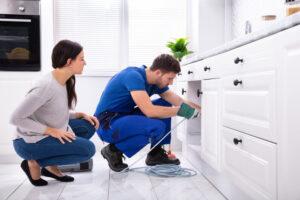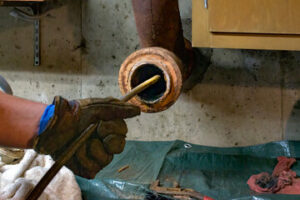Water Quality Testing Colorado can identify germs and harmful chemicals in your water. This is important if you live in an area with outdated plumbing, nearby fracking or mining operations, and natural disasters like flooding.
Water potability testing looks for coliform bacteria, pH, nitrates, sodium, iron, and hardness. It also identifies nuisance contaminants such as hydrogen sulfide and iron bacteria.

Home water quality testing kits typically include strips exposed to a water sample and then compared against a color chart. These kits can test for bacteria, lead, pesticides, nitrates/nitrites, chlorine, hardness, and pH. Typically, the test kit directions will specify how long each strip type should be exposed to the water and the temperature at which it should be tested.
The pH value of water is a measure of the concentration of hydrogen (H+) and hydroxide (OH-) ions in a solution. Solutions with a pH below 7.0 are considered acidic, while those above 7.0 are considered basic or alkaline.
Most public water supplies and private wells must adhere to the EPA’s minimum legal limits for more than 90 contaminants. However, many people opt to test their water for additional contaminants of particular concern in their area or community.
Additional tests may be performed using handheld digital instruments that are designed to screen for bacteria, metals such as arsenic and fluoride, as well as other chemical parameters like conductivity and turbidity. These instruments require special training and calibration, so they are best left to professionals.
The TDS value of water quality test water measures the total amount of minerals, metals, organic matter, and salts dissolved in a sample. It can be determined by a conductivity sensor in laboratory settings and is expressed as mg/L. Like pH, it indicates the amount of contaminants in a water supply and can help determine whether a system works correctly or should be changed. For example, high TDS levels can indicate a build-up of calcium and magnesium, which can lead to scale formation in pipes and appliances that decrease their efficiency or add to maintenance costs. These chemicals also may pose a health threat if consumed in large quantities.
Although TDS can be measured with a simple TDS meter, the most accurate way to know exactly what is in your water is to test it for specific impurities using a home water testing kit or lab analysis. TDS is generally considered to be a good indicator of water quality. The lower the TDS level, the purer the water. The hydroponically experienced TDS is often called PPM or parts per million (meaning that out of a million particles in your water sample, only 1100 are TDS). TDS can include anything from pure H2O molecules to dissolved iron and arsenic.
While water alkalinity may seem like a minor parameter to monitor, it is important. Alkalinity affects the ability of water to buffer acidic conditions and helps regulate pH levels. It is also an important factor for lakes and ponds when applying algaecides.
In the simplest terms, water alkalinity measures the amount of carbonate (CO3-), bicarbonate (HCO3-), and hydroxide (OH-) in a sample. It can be measured using a digital titrator with bromocresol green/methyl red or phenolphthalein indicators. The titration process involves adding a strong acid to the sample until it reaches a designated endpoint, determined using the indicator.
Water quality test kits test pH, Total Alkalinity, and Total Hardness in one easy-to-use package. Its foil-packed strips feature detailed color charts for quick and accurate results. Unlike other testing kits that contain dangerous chemicals, SimplexHealth uses noncarcinogenic, environmentally friendly indicators for its tests. Its patented technology ensures no cross-reactions between different chemicals and allows the indicator to react with the target element without interference from other materials.
Chlorine is the most commonly used chemical for disinfecting drinking water. It is also active for many other purposes associated with water treatment and supply, such as prevention of algal, bacterial, and general slime growths in plant and pipeworks, control of tastes, odors, and color, and removal of iron, manganese, and color (White, 1986).
The chlorine used for chlorination of drinking water is normally added as hypochlorite or chlorine dioxide. It is counted sufficiently to achieve a residual of free chlorine and chloramine at consumer taps, generally 0.5-2 mg/l.
This is different from the practice of some areas in which chlorine levels are deliberately maintained low in distribution systems to avoid generating toxic by-products. The chlorine-to-carbon molar ratios of these by-products and those produced during the chlorination reaction are much lower than those found in ingested water in the human gastrointestinal tract, which may explain why there appears to be no epidemiological evidence of harm caused by high chlorine residuals in drinking water systems.
The chlorine value of your tap water can be tested using a household kit available from some hardware stores and online retailers. Follow the instructions carefully. Ensure that the test is performed on freshly gathered, cold tap water. Water stored in the refrigerator or pipes will give inaccurate results.
The oxygen value of water quality test water depends on the temperature, pressure, and salinity. The amount of organic material present also influences it. Water bodies receive oxygen from the atmosphere and aquatic plants. Running water contains more dissolved oxygen than still water.
Testing kits are available for analyzing water quality, including tests for lead and chlorine levels, as well as coliforms. These can be used to assess the overall health of your home water supply but are less comprehensive than a lab analysis. A simple, affordable kit from Health Metric has reliable test strips for nine common contaminants and overall pH but doesn’t include a screen for pesticides.
The most important thing to remember when testing your water is that the results are only as accurate as the equipment and methods used. It’s also worth mentioning that different contaminants have different concentrations. For example, a high level of lead in the water might be a problem, but a low level of nitrates could not be a problem. Concentrations are often expressed in milligrams per liter (mg/L) or parts per million (ppm). One ppm is the equivalent of about 0.03 of a teaspoon of sugar dissolved in a bathtub of water.
A value for nitrogen measures the amount of the element in water. Nitrogen is a common pollutant in drinking water and can contribute to developing dead zones in lakes and oceans. The nitrogen level of your water can be measured with test strips or a digital meter. High levels of nitrates are associated with agricultural pollution from fertilizers and human waste (both from latrines and sewage treatment plants).
The nitrate and total coliform values on your water quality test indicate how harmful the water is to drink. However, it’s also important to consider how other contaminants may affect the overall water quality. For example, the presence of arsenic and fluoride can be dangerous to humans if consumed in large quantities.
Once the lab tests your water, you’ll receive a detailed results report. These reports will include the amount of each contaminant in your water and whether or not it meets PA DEP standards. Most importantly, these reports will highlight any contaminant values that exceed the PA DEP standards.
The results will be displayed in units called parts per million (ppm). A part per million equals one million parts of water and is used for measuring very small amounts of chemicals such as metals or nitrates.
Total coliforms are bacteria that may be present in drinking water. They are normally found in the digestive tracts of animals, including humans, and in animal waste and plant material. They are sensitive to common disinfection practices and can be used as an indicator of other bacteria that may be present in your well water. Many coliform testing methods rely on color changes and express the results as “present” or “absent.” These presence/absence methods are less expensive and faster than enumeration methods, but they provide limited information about your water quality.
Water samples are analyzed for the presence of coliforms by passing 100 milliliters (mL) of your water through a membrane filter and then incubating the filter overnight on a petri dish with a special agar that contains a nutrient to encourage bacterial growth. Bacteria colonies are then counted. A negative coliform result indicates that your well water is microbiologically safe to drink. A positive coliform result, especially for fecal coliforms or E. coli, suggests that your water is likely contaminated with disease-causing pathogens and may need additional testing and treatment. It recommends that all private wells, springs, and cisterns serving individual households be tested for coliforms at least once yearly.


